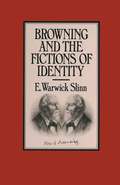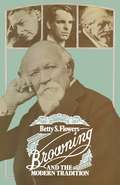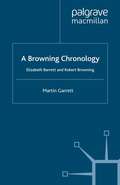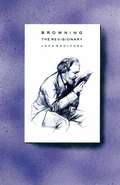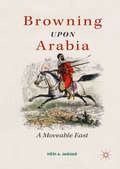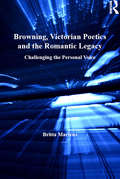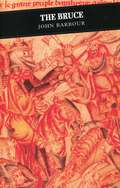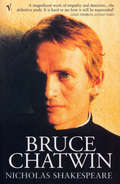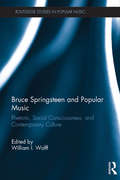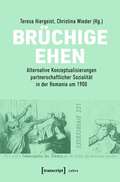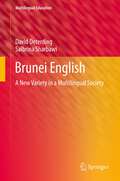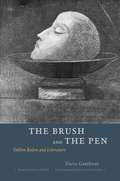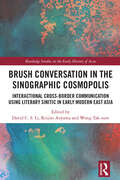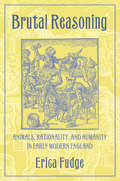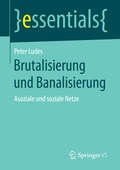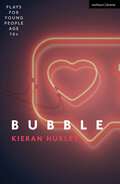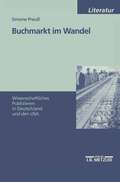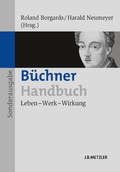- Table View
- List View
A Browning Chronology: Elizabeth Barrett and Robert Browning (Author Chronologies Series)
by M. GarrettSeveral thousand letters to and from Elizabeth Barrett and Robert Browning have survived, together with other information on the composition and context of works from Barrett's 'lines on virtue' written at the age of eight in 1814 to Browning's Asolando (1889). The Chronology seeks to guide readers through this mass of material in three main sections: youth, contrasting early backgrounds and careers, and growing interest in each other's work to 1845; courtship, marriage, Italy, and work including Aurora Leigh and Men and Women (1845-61); Browning's later life of relentless socializing and prolific writing from his return to London to his death in Venice in 1889. The book provides not only precise dating but much matter on such topics as the Brownings' extensive reading in English, French and classical literature, their many friendships, and their sometimes conflicting political beliefs.
Browning Upon Arabia: A Moveable East
by Hédi A. JaouadBrowning Upon Arabia charts Robert Browning’s early and enduring engagement with the East, particularly the Arab East. This book highlights the complexities of Browning’s poetry, revealing Browning’s resistance to triumphalist and imperialist forms of Orientalism generated by many nineteenth-century British and European literary and scholarly portrayals of the East. Hédi A. Jaouad argues that Browning extensively researched the literature, history, philosophy, and culture of the East to produce poetry that is sensitive to its Eastern resources and devoted to confirming the interrelation of Northern and Eastern knowledge in pursuit of a new form of transcendental humanism.
Browning Upon Arabia: A Moveable East
by Hédi A. JaouadBrowning Upon Arabia charts Robert Browning’s early and enduring engagement with the East, particularly the Arab East. This book highlights the complexities of Browning’s poetry, revealing Browning’s resistance to triumphalist and imperialist forms of Orientalism generated by many nineteenth-century British and European literary and scholarly portrayals of the East. Hédi A. Jaouad argues that Browning extensively researched the literature, history, philosophy, and culture of the East to produce poetry that is sensitive to its Eastern resources and devoted to confirming the interrelation of Northern and Eastern knowledge in pursuit of a new form of transcendental humanism.
Browning, Victorian Poetics and the Romantic Legacy: Challenging the Personal Voice
by Britta MartensTaking an original approach to Robert Browning's poetics, Britta Martens focuses on a corpus of relatively neglected poems in Browning's own voice in which he reflects on his poetry, his self-conceptualization and his place in the poetic tradition. She analyzes his work in relation to Romanticism, Victorian reactions to the Romantic legacy, and wider nineteenth-century changes in poetic taste, to argue that in these poems, as in his more frequently studied dramatic monologues, Browning deploys varied dramatic methods of self-representation, often critically and ironically exposing the biases and limitations of the seemingly authoritative speaker 'Browning'. The poems thus become devices for Browning's detached evaluation of his own and of others' poetics, an evaluation never fully explicit but presented with elusive economy for the astute reader to interpret. The confrontation between the personal authorial voice and the dramatic voice in these poems provides revealing insights into the poet's highly self-conscious, conflicted and sustained engagement with the Romantic tradition and the diversely challenging reader expectations that he faces in a post-Romantic age. As the Victorian most rigorous in his rejection of Romantic self-expression, Browning is a key transitional figure between the sharply antagonistic periods of Romanticism and Modernism. He is also, as Martens persuasively demonstrates, a poet of complex contradictions and an illuminating case study for addressing the perennial issues of voice, authorial authority and self-reference.
Browning, Victorian Poetics and the Romantic Legacy: Challenging the Personal Voice
by Britta MartensTaking an original approach to Robert Browning's poetics, Britta Martens focuses on a corpus of relatively neglected poems in Browning's own voice in which he reflects on his poetry, his self-conceptualization and his place in the poetic tradition. She analyzes his work in relation to Romanticism, Victorian reactions to the Romantic legacy, and wider nineteenth-century changes in poetic taste, to argue that in these poems, as in his more frequently studied dramatic monologues, Browning deploys varied dramatic methods of self-representation, often critically and ironically exposing the biases and limitations of the seemingly authoritative speaker 'Browning'. The poems thus become devices for Browning's detached evaluation of his own and of others' poetics, an evaluation never fully explicit but presented with elusive economy for the astute reader to interpret. The confrontation between the personal authorial voice and the dramatic voice in these poems provides revealing insights into the poet's highly self-conscious, conflicted and sustained engagement with the Romantic tradition and the diversely challenging reader expectations that he faces in a post-Romantic age. As the Victorian most rigorous in his rejection of Romantic self-expression, Browning is a key transitional figure between the sharply antagonistic periods of Romanticism and Modernism. He is also, as Martens persuasively demonstrates, a poet of complex contradictions and an illuminating case study for addressing the perennial issues of voice, authorial authority and self-reference.
The Bruce: Being The Metrical History Of Robert The Bruce, King Of Scots (Canongate Classics #78)
by John BarbourEdited and introduced by A.A.M. Duncan. A! Fredome is a noble thing Fredome mays man to haiff liking Fredome all solace to man giffis He levys at es that frely levys These are some of the most famous lines in Scottish literature. They were written c.1375 by John Barbour, Archdeacon of Aberdeen, as a celebration of the Age of Chivalry – an age of bravery, valour, and above all loyalty. Its twin heroes are Robert the Bruce and James Douglas, his faithful companion. The epic sweep and scale of the poem catch the full drama of Bruce’s life – from being pursued by dogs in Galloway to his great triumph at Bannockburn, from hunted fugitive surrounded by traitors to kingship of a free nation. The poem is one of the key sources for any life of Bruce and incorporates much information not found elsewhere. The language of the poem is easy to read and its vigour and imagery provide a marvellous insight into the medieval mind. This is the first accessible modern edition of The Bruce featuring a full historical introduction, a special commentary on Bannockburn, a facing page translation with extensive annotation and six detailed maps. This edition also includes the other great nationalist statement about the reign of Robert the Bruce, The Declaration of Arbroath. A.A.M. Duncan’s work on The Bruce represents the culmination of a life-long interest and this book, comprehensively revised in 2007, marks a radical reassessment of the history of Robert the Bruce as recounted in the poem which bears his name.
Bruce Chatwin: A Biography
by Nicholas ShakespeareBruce Chatwin's death in 1989 brought a meteoric career to an abrupt end, since he burst onto the literary scene in 1977 with his first book, In Patagonia.Chatwin himself was different things to different people: a journalist, a photographer, an art collector, a restless traveller and a bestselling author; he was also a married man, an active homosexual, a socialite who loved to mix with the rich and famous, and a single-minded loner who explored the limits of extreme solitude.From unrestricted access to Chatwin's private notebooks, diaries and letters, Nicholas Shakespeare has compiled the definitive biography of one of the most charismatic and elusive literary figures of our time.'A magnificent work of empathy and detection'Colin Thubron, Sunday Times'Utterly compelling'Philip Marsden, Mail on Sunday'A fascinating account of the man behind the myth'Ian Thomson, Guardian
Bruce Springsteen and Popular Music: Rhetoric, Social Consciousness, and Contemporary Culture (Routledge Studies in Popular Music)
by William I. WolffThis interdisciplinary volume enters the scholarly conversation about Bruce Springsteen at the moment when he has reinforced his status of global superstar and achieved the status of social critic. Covering musical and cultural developments, chapters primarily consider work Springsteen has released since 9/11—that is, released during a period of continued global unrest, economic upheaval, and social change—under the headings Politics, Fear and Society; Gender and Sexual Identity; and Toward a Rhetoric of Springsteen. The collection engages Springsteen and popular music as his contemporary work is just beginning to be understood in terms of its impact on popular culture and music, applying new areas of inquiry to Springsteen and putting Springsteen fan writing within the same binding as academic writing to show how together they create a more nuanced understanding of an artist. Established and emerging Springsteen scholars approach work from disciplines including rhetoric and composition, historical musicology, labor studies, American history, literature, communications, sociology, theology, and government. Offering context, critique, and expansive understanding of Springsteen and his work, this book contributes to Springsteen scholarship and the study of popular music by showing Springsteen’s broadening academic appeal as well as his escalating legacy on new musicians, social consciousness, and contemporary culture.
Bruce Springsteen and Popular Music: Rhetoric, Social Consciousness, and Contemporary Culture (Routledge Studies in Popular Music)
by William I. WolffThis interdisciplinary volume enters the scholarly conversation about Bruce Springsteen at the moment when he has reinforced his status of global superstar and achieved the status of social critic. Covering musical and cultural developments, chapters primarily consider work Springsteen has released since 9/11—that is, released during a period of continued global unrest, economic upheaval, and social change—under the headings Politics, Fear and Society; Gender and Sexual Identity; and Toward a Rhetoric of Springsteen. The collection engages Springsteen and popular music as his contemporary work is just beginning to be understood in terms of its impact on popular culture and music, applying new areas of inquiry to Springsteen and putting Springsteen fan writing within the same binding as academic writing to show how together they create a more nuanced understanding of an artist. Established and emerging Springsteen scholars approach work from disciplines including rhetoric and composition, historical musicology, labor studies, American history, literature, communications, sociology, theology, and government. Offering context, critique, and expansive understanding of Springsteen and his work, this book contributes to Springsteen scholarship and the study of popular music by showing Springsteen’s broadening academic appeal as well as his escalating legacy on new musicians, social consciousness, and contemporary culture.
Brüchige Ehen: Alternative Konzeptualisierungen partnerschaftlicher Sozialität in der Romania um 1900 (Lettre)
by Teresa Hiergeist Christina WiederDie Ehe stellt das Sozialmodell par excellence der bürgerlichen Moderne dar. Mit der Integration von Liebe, Freundschaft und Sexualität schafft sie den Brückenschlag zwischen Privatheit und Öffentlichkeit. Doch so prädestiniert sie hinsichtlich der Absorption der politischen, wirtschaftlichen und kulturellen Bedingungen und Bedürfnisse der bürgerlichen Moderne scheint, so sehr steht sie auch in der Kritik. Die Beiträger*innen nehmen diskursive Infragestellungen der Ehe in kulturellen Artefakten der Romania von 1870 bis 1930 in den Blick und analysieren sie aus kultur- und literaturwissenschaftlicher Perspektive.
Brunei English: A New Variety in a Multilingual Society (Multilingual Education #4)
by David Deterding Salbrina SharbawiThis detailed survey of Brunei English reflects the burgeoning academic interest in the many new varieties of English which are fast evolving around the world. Wholly up to date, the study is based on careful analysis of a substantial dataset that provides real-life examples of usage to illustrate the narrative throughout. As well as a thorough account of the pronunciation, grammar, vocabulary usage, and discourse patterns of Brunei English, the volume explores its historical and educational background and current developmental trends, providing an in-depth review of the patterns of English usage within this multilingual, oil-rich society on the north-western coast of Borneo. Written in a non-technical style throughout that will assist non-specialists wishing to grasp the fundamentals of this unique brand of the English language, the work is a worthy addition to Springer’s series on multilingual education that plugs a gap in the coverage of the numerous varieties of English being used across South East Asia. “The authors bring renewed and badly needed attention to the long-overlooked development of Brunei English. Their examination of the variety not only documents the features and functions of English within Brunei society, it also suggests the development of regional or global varieties of English that extend beyond Brunei, and even beyond South East Asia.” Andrew Moody, University of Macau
The Brush and the Pen: Odilon Redon and Literature
by Dario GamboniFrench symbolist artist Odilon Redon (1840–1916) seemed to thrive at the intersection of literature and art. Known as “the painter-writer,” he drew on the works of Poe, Baudelaire, Flaubert, and Mallarmé for his subject matter. And yet he concluded that visual art has nothing to do with literature. Examining this apparent contradiction, The Brush and the Pen transforms the way we understand Redon’s career and brings to life the interaction between writers and artists in fin-de-siècle Paris. Dario Gamboni tracks Redon’s evolution from collaboration with the writers of symbolism and decadence to a defense of the autonomy of the visual arts. He argues that Redon’s conversion was the symptom of a mounting crisis in the relationship between artists and writers, provoked at the turn of the century by the growing power of art criticism that foreshadowed the modernist separation of the arts into intractable fields. In addition to being a distinguished study of this provocative artist, The Brush and the Pen offers a critical reappraisal of the interaction of art, writing, criticism, and government institutions in late nineteenth-century France.
The Brush and the Pen: Odilon Redon and Literature
by Dario GamboniFrench symbolist artist Odilon Redon (1840–1916) seemed to thrive at the intersection of literature and art. Known as “the painter-writer,” he drew on the works of Poe, Baudelaire, Flaubert, and Mallarmé for his subject matter. And yet he concluded that visual art has nothing to do with literature. Examining this apparent contradiction, The Brush and the Pen transforms the way we understand Redon’s career and brings to life the interaction between writers and artists in fin-de-siècle Paris. Dario Gamboni tracks Redon’s evolution from collaboration with the writers of symbolism and decadence to a defense of the autonomy of the visual arts. He argues that Redon’s conversion was the symptom of a mounting crisis in the relationship between artists and writers, provoked at the turn of the century by the growing power of art criticism that foreshadowed the modernist separation of the arts into intractable fields. In addition to being a distinguished study of this provocative artist, The Brush and the Pen offers a critical reappraisal of the interaction of art, writing, criticism, and government institutions in late nineteenth-century France.
The Brush and the Pen: Odilon Redon and Literature
by Dario GamboniFrench symbolist artist Odilon Redon (1840–1916) seemed to thrive at the intersection of literature and art. Known as “the painter-writer,” he drew on the works of Poe, Baudelaire, Flaubert, and Mallarmé for his subject matter. And yet he concluded that visual art has nothing to do with literature. Examining this apparent contradiction, The Brush and the Pen transforms the way we understand Redon’s career and brings to life the interaction between writers and artists in fin-de-siècle Paris. Dario Gamboni tracks Redon’s evolution from collaboration with the writers of symbolism and decadence to a defense of the autonomy of the visual arts. He argues that Redon’s conversion was the symptom of a mounting crisis in the relationship between artists and writers, provoked at the turn of the century by the growing power of art criticism that foreshadowed the modernist separation of the arts into intractable fields. In addition to being a distinguished study of this provocative artist, The Brush and the Pen offers a critical reappraisal of the interaction of art, writing, criticism, and government institutions in late nineteenth-century France.
Brush Conversation in the Sinographic Cosmopolis: Interactional Cross-border Communication using Literary Sinitic in Early Modern East Asia (Routledge Studies in the Early History of Asia)
by David C. S. Li Reijiro Aoyama Wong Tak-SumFor hundreds of years until the 1900s, in today’s China, Japan, North and South Korea, and Vietnam, literati of Classical Chinese or Literary Sinitic (wényán 文言) could communicate in writing interactively, despite not speaking each other’s languages. This book outlines the historical background of, and the material conditions that led to,widespread literacy development in premodern and early modern East Asia, where reading and writing for formal purposes was conducted in Literary Sinitic. To exemplify how ‘silent conversation’ or ‘brush-assisted conversation’ is possible through writing-mediated brushed interaction, synchronously face-to-face, this book presents contextualized examples from recurrent contexts involving (i) boat drifters; (ii) traveling literati; and (iii) diplo- matic envoys. Where profound knowledge of classical canons and literary works in Sinitic was a shared attribute of the brush-talkers concerned, their brush-talk would characteristically be intertwined with poetic improvisation. Being the first monograph in English to address this fascinating lingua-cultural practice and cross-border communication phenomenon, which was possibly sui generis in Sinographic East Asia, it will be of interest to students of not only East Asian languages and linguistics, history, international relations, and diplomacy, but also (historical) pragmatics, sociolinguistics, sociology of language, scripts and writing systems, and cultural and linguistic anthropology.
Brush Conversation in the Sinographic Cosmopolis: Interactional Cross-border Communication using Literary Sinitic in Early Modern East Asia (Routledge Studies in the Early History of Asia)
by David C. S. Li Reijiro Aoyama Tak-Sum WongFor hundreds of years until the 1900s, in today’s China, Japan, North and South Korea, and Vietnam, literati of Classical Chinese or Literary Sinitic (wényán 文言) could communicate in writing interactively, despite not speaking each other’s languages. This book outlines the historical background of, and the material conditions that led to,widespread literacy development in premodern and early modern East Asia, where reading and writing for formal purposes was conducted in Literary Sinitic. To exemplify how ‘silent conversation’ or ‘brush-assisted conversation’ is possible through writing-mediated brushed interaction, synchronously face-to-face, this book presents contextualized examples from recurrent contexts involving (i) boat drifters; (ii) traveling literati; and (iii) diplo- matic envoys. Where profound knowledge of classical canons and literary works in Sinitic was a shared attribute of the brush-talkers concerned, their brush-talk would characteristically be intertwined with poetic improvisation. Being the first monograph in English to address this fascinating lingua-cultural practice and cross-border communication phenomenon, which was possibly sui generis in Sinographic East Asia, it will be of interest to students of not only East Asian languages and linguistics, history, international relations, and diplomacy, but also (historical) pragmatics, sociolinguistics, sociology of language, scripts and writing systems, and cultural and linguistic anthropology.
Brutal Reasoning: Animals, Rationality, and Humanity in Early Modern England
by Erica FudgeEarly modern English thinkers were fascinated by the subject of animal rationality, even before the appearance of Descartes's Discourse on the Method (1637) and its famous declaration of the automatism of animals. But as Erica Fudge relates in Brutal Reasoning, the discussions were not as straightforward—or as reflexively anthropocentric—as has been assumed. Surveying a wide range of texts-religious, philosophical, literary, even comic-Fudge explains the crucial role that reason played in conceptualizations of the human and the animal, as well as the distinctions between the two. Brutal Reasoning looks at the ways in which humans were conceptualized, at what being "human" meant, and at how humans could lose their humanity. It also takes up the questions of what made an animal an animal, why animals were studied in the early modern period, and at how people understood, and misunderstood, what they saw when they did look.From the influence of classical thinking on the human-animal divide and debates surrounding the rationality of women, children, and Native Americans to the frequent references in popular and pedagogical texts to Morocco the Intelligent Horse, Fudge gives a new and vital context to the human perception of animals in this period. At the same time, she challenges overly simplistic notions about early modern attitudes to animals and about the impact of those attitudes on modern culture.
Brutalisierung und Banalisierung: Asoziale und soziale Netze (essentials)
by Peter LudesPeter Ludes entlarvt Brutalisierung und Banalisierung in kollektiven Mythen – für eine Emanzipation der Sinne im Zeitalter ihrer technischen Vereinnahmung. Denn Informations- und Kommunikationstechnologien dienen nicht nur der Ausweitung von Kommunikation, sondern auch als Kampfmittel. Insoweit sie aufgrund ihrer leicht zugänglichen, scheinbar kostenlosen Verbreitung als relativ natürliche Weltbedingungen erlebt werden, konstituieren sie neue Mythen der unbegrenzten, freien Kommunikation. Welche Perspektiven und Praktiken werden aber wie vorgegeben und formatiert? Wie wird das komplexe und widersprüchliche Zusammenspiel und Gegeneinander von fiktiven Behauptungen und verdrängten ‚Tat-Sachen‘ zu einem neuen Problem? Es geht zum Schluss um unterschiedlich vernetzte lokale Kontakt- und globale virtuelle Machtzonen, die hier symbolisch aufgehoben werden mit Abrechnungen für die acht reichsten Männer der Erde.Der Autor Dr. Peter Ludes, PhD (USA), habilitierter Soziologe, apl. Professor für Kultur- und Medienwissenschaft in Siegen. Professor für Massenkommunikation an der Jacobs University Bremen 2002-2017, Gastprofessor an der Universität Köln.
Bubble (Plays for Young People)
by Kieran HurleyI was there you know. when we shut your places down. gender studies. social studies. the strongholds of your politically correct bullshit worldview. we shut them down. and I was there. and the news cameras were there. and the whole world was watching. What happens when a male lecturer calls a female student a slut?A provocative, dynamic and original play by award-winning writer Kieran Hurley. Set entirely on Facebook and written in both text and emjois, it explores the disconnect between online persona and true personality, the fractured nature of online debate and how events can snowball in expected ways.Bubble was originally commissioned and developed as a stage play as part of The Royal Conservatoire of Scotland's MA Classical and Contemporary Text Programme with support from the Playwrights' Studio, Scotland. It was later developed as a digital theatre production by Theatre Uncut and streamed by 195,000 people online and watched in 32 countries.
Bubble (Plays for Young People)
by Kieran HurleyI was there you know. when we shut your places down. gender studies. social studies. the strongholds of your politically correct bullshit worldview. we shut them down. and I was there. and the news cameras were there. and the whole world was watching. What happens when a male lecturer calls a female student a slut?A provocative, dynamic and original play by award-winning writer Kieran Hurley. Set entirely on Facebook and written in both text and emjois, it explores the disconnect between online persona and true personality, the fractured nature of online debate and how events can snowball in expected ways.Bubble was originally commissioned and developed as a stage play as part of The Royal Conservatoire of Scotland's MA Classical and Contemporary Text Programme with support from the Playwrights' Studio, Scotland. It was later developed as a digital theatre production by Theatre Uncut and streamed by 195,000 people online and watched in 32 countries.
Buchmarkt im Wandel: Wissenschaftliches Publizieren in Deutschland und den USA
by Simone PreußWissenschaftliches Publizieren ist bis jetzt in der Fachliteratur wenig dokumentiert worden. Was verbirgt sich hinter dem Kriterium »wissenschaftlich«? Wo überschneidet sich die Distribution wissenschaftlicher Medien von der anderer Literatur? Welchen Stellenwert haben die Printmedien noch für die Wissenschaft? Diesen und weiteren Fragen ist Simone Preuß nachgegangen. Verlage, Buchhandlungen, Bibliotheken, RezipientInnnen und nicht zuletzt das wissenschaftliche Medium selbst stehen im Mittelpunkt ihrer Analyse. Besonders anschaulich wird die Darstellung durch den Vergleich des wissenschaftlichen Buchmarkts in Deutschland und den USA - sein jeweiliger Aufbau und die spezifische Organisation zeigen nationale Besonderheiten, aber auch die Bandbreite zweier einflußreicher Buchmärkte im internationalen Vergleich. Vor dem Hintergrund der Entwicklung der Neuen Medien und dem damit verbundenen Funktionswandel des Buches zeigt sich der allgemeine Wandel, dem die Buchbranche unterworfen ist. Seine Aufzeichnung und die Veranschaulichung der brancheninternen Kommunikation ist ein wichtiger Beitrag zur Stellung des wissenschaftlichen Mediums im Informatiationszeitalter.
Büchner-Handbuch: Leben – Werk – Wirkung
Büchner wieder lesen, heißt die eigene Lage schärfer sehn. So umschreibt Christa Wolf die ungebrochene Aktualität Georg Büchners, dessen vielschichtiges uvre bis heute immer wieder zum Nachdenken auffordert. Neben Beiträgen zur Rezeption und Wirkung bietet das Handbuch detaillierte Analysen der Einzelwerke, die sowohl die Entstehungs- und Gattungsgeschichte als auch die gängigen Forschungsansätze berücksichtigen. Zudem beleuchten interpretatorische Querschnitte durch das Gesamtwerk übergreifende Themenfelder wie z. B. Religion, Biopolitik, Geschlecht, Recht und Strafe, Melancholie und Wahnsinn, Automaten und Marionetten, Dokumentation und Fiktion.
